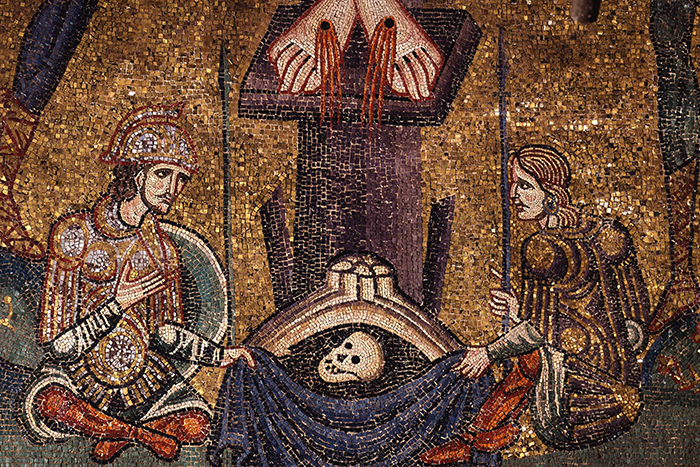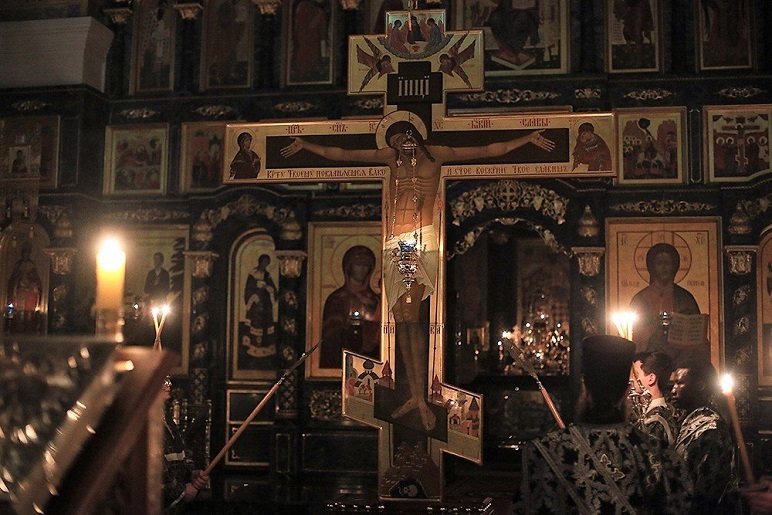
Divine Providence has preserved for us numerous sacred items scattered throughout the earth. Perhaps the greatest historical treasure is the Lord’s Chiton. There are several known accounts of the whereabouts of this holy object and each deserves our attention. So where is the Lord’s Chiton?
Svetitskhoveli
According to an ancient Georgian legend, at the time of Jesus’ crucifixion, Rabbi Eleazar, a descendant of Jewish settlers in Iberia, was in Jerusalem. He believed in the Messiah and bought the seamless Chiton, which the soldiers cast lots about, from one of the soldiers who had crucified Christ (see John 19:23). He brought it to his home city of Mtskheta and gave it to his sister Sidonia, who died upon hearing the news of the Crucifixion of the Messiah. She was buried with Chiton in her hands. A wonder-working cedar tree grew on the grave site. When St. Nina (†335) converted King Mirian (†360) into Christianity, he decided to build the first church in his garden, where the sacred cedar grew. Miracles accompanied the foundation of God’s first house. It is said that they could not cut down the tree for a long time, after which it miraculously rose into the air. Fragrant myrrh flowed from this tree, which had grown on the relics of St. Sidonia and the Chiton of the Lord, and there were numerous healings. It became known as Svetitskhoveli (cargo. სვეტიცხოველი – Life-Giving Pillar), and served as one of the pillars of the first wooden temple. The people who received the healings wanted to get a piece of the holy tree, and the king, fearing that it would be cut into pieces, ordered, with the blessing of the local bishop, to cover the miraculous pillar with limestone and fence it. Sources call this church “Holy of Holies” and say that “no one dared to enter it except on Sundays; only priests would sing psalms there”. King Mirian was so reverent before it that he “did not dare always touch its doors.” (Moktsevai Kartlisai. 1963, 160). The Georgian Church keeps this ancient tradition and many Orthodox Christians believe that the Chiton of the Lord is still preserved beneath the Pillar of Life in the Church of the Twelve Apostles in Mtskheta.
Trier
There is an ancient legend that the Chiton of the Lord is kept in the Cathedral of Trier. Trier was the capital of the Western Roman Empire and the headquarters of Emperor Constantine for a while. It was here, according to popular lore, that St. Helen, Constantine’s mother, brought the Lord’s Chiton, which she had found in Jerusalem along with the Life-Giving Cross. Because of barbarian raids, the sacred objects were often reburied. There are no credible sources of the Chiton being kept in Trier, but it has been established historically that since 1100, the citizens of Trier were convinced that it was them who stored this treasure, which they had inherited from Empress Helen. The Life of St. Agricius of Trier († c. 330), written in the 11th century, cites the “authentic testimony of the preceding fathers” to state that one of the pious bishops of Trier had opened the treasury of the cathedral and, among other relics, had found the garment of the Lord. Some claimed that it was the Lord’s Chiton, and some claimed that it was the purple robe Jesus was wearing during His Passion (Monumenta Germ. Hist., Script., VIII, 211). Subsequently, the Chiton of Jesus was buried in the altar of the Cathedral for several centuries, until in 1512, at the insistence of Emperor Maximian I (1508-1519), it was removed from the treasury and shown to the worshipers. Since then, the Chiton has been exhibited every seven years for worship, and there have been recorded cases of healing. The last time the relic was exhibited for worship was in 2012. Scientists find it difficult to establish the time when this relic came into being, because it has been regularly mended with new fabrics.
Argenteuil
The Christians in Paris claim that it is they who keep the Chiton. Empress Irene (†803) allegedly presented it to Charlemagne, King of the Franks, and he gave it to his daughter Theodrada, the abbess of a Benedictine abbey in a neighborhood of the burgeoning Paris. The earliest document that bears witness to this relic, the Charter of Hugh of Rouen, dates back to 1156. In this charter, the Archbishop of Rouen writes that there is Cappa pueri Jesu (Clothes of Baby Jesus) in the treasury of the Benedictine abbey in Argenteuil “since ancient times” and that he and other bishops and abbots have verified its authenticity and exhibited the sacred object for worship. Over time, people began to believe that it was the Chiton that was kept in Argenteuil. Proponents of this tradition frowned upon the Cathedral in Trier calling its sacred object the Chiton. While they acknowledge the authenticity of the Trier relic, they believe it to be the Lord’s mantle, which He had worn on top of the Chiton. The supporters of the Trier version consider the Argenteuil relic to be the garment of the Baby Jesus. History has not spared the Argenteuil treasure. The abbey was devastated during the French Revolution, and the relic was transferred to a local parish, where, for fear of desecration, the priest cut the garment into pieces and concealed them in various places. The surviving pieces were later returned to the Argenteuil church and displayed for worship a few times.
So, there are several legends about the whereabouts of the Lord’s Chiton that compete with each other. The history of relics is sometimes very confusing and it is not fully clear which of the Savior’s Clothes (Chiton, Mantle, Purple Robe, etc.) is where. The major lesson for us is to remember that, despite the holiness and historical value of Christian relics, it is the Word of Christ, recorded in the Gospel, and His Sacrifice, which was partake of in the Sacrament of Eucharist, that should occupy the minds and hearts of the faithful.



